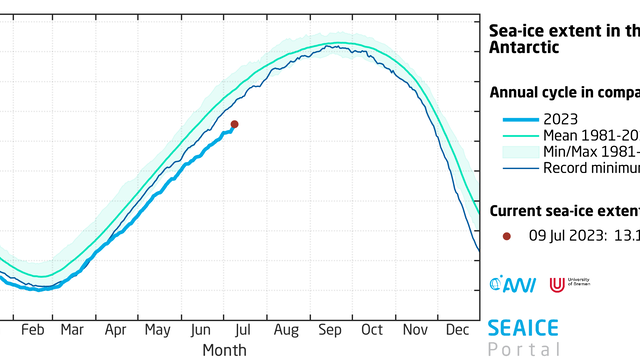This year, sea-ice development in the Antarctic is progressing extremely slowly and, after May, once again reached a record-low monthly sea-ice extent in June. At 11.23 million km², the monthly mean sea-ice extent in June was ca. 1.1 million km² below the previous low from 2022 and is unique in size, which puts it below the long-term trend since the beginning of continuous satellite observation in 1979 (Figure 1). The mean ice extent was more than 2.1 million km² below the long-term mean for the years 1979 – 2022 (ca. 13.4 million km²), an area the size of Greenland or roughly six times the size of Germany. At the end of June, only 12.41 million km² of the Southern Ocean were covered with sea ice (Figure 2).
Although the freezing season had already begun in the Antarctic, sea-ice formation was sluggish (Figure 3), progressing similarly to the past record-minimum year 2022, with low ice cover in the first months of autumn (March and April in the Southern Hemisphere). Since mid-April it had become apparent that the sea-ice formation was lower than in previous years, after which it successively remained below the sea-ice extent curve for 2022. Following the new record-low monthly minimum in May, June fell even farther below the previous trends.
In comparison to the long-term mean for the years 2003 – 2014 (Figure 4), especially in the Weddell Sea, D’Urville Sea and Bellingshausen Sea, there is significantly less sea ice, whereas a minor increase in ice cover can be seen in the western Ross Sea and the Amundsen Sea. The distribution of air temperatures over the Antarctic rounds out the picture. With the exception of the Amundsen Sea/Ross Sea sector, air temperatures are between 2° and 3° Celsius above the long-term mean for the years 1971 – 2000 throughout the Antarctic; in the Bellingshausen Sea and southern Weddell Sea, they are up to 6° C above the mean (Figure 5). Though this definitely affects new ice formation, the causes of this truly unusual development in the Antarctic remain unclear.
At the International Glaciological Society (IGS) sea-ice symposium “Sea Ice Across Temporal and Spatial Scales”, organised by the Alfred Wegener Institute, Helmholtz Centre for Polar and Marine Research and the University of Bremen, this unanswered question was the subject of numerous papers and discussions. “Until now, the focus in Antarctic sea-ice research has largely been on describing the status quo, since we still don’t adequately understand many of the processes and interrelations in the Southern Ocean’s complex sea-ice system. Yet the latest developments in the Antarctic sea ice, in the summer and winter months alike, have increasingly shifted the focus of discussions among the scientific community to the chronological evolution and major changes,” said sea-ice physicist Dr Stefanie Arndt. “Nevertheless, it’s too soon to claim there is a significant negative trend in the Antarctic sea-ice extent, akin to the one seen in the Arctic,” she underscored.
Whereas we can clearly attribute sea-ice retreat in the Arctic to global warming and the polar amplification observed in the region, the global warming trend has yet to be definitively identified in the Antarctic. In the last 50 years, a clearly recognisable warming trend of 0.5 °C per decade has emerged near the Antarctic Peninsula, yet the Antarctic continent – thanks to its ice sheet and the polar gyre it produces – is protected by a belt of powerful westerly winds (the polar jet stream) that prevents the intrusion of warm air masses from the temperate latitudes. “If we consider the development of the Antarctic sea ice over the past few decades, time and again we see high interannual variability. We’ll have to wait and see how this pronounced negative trend in the ice-covered Southern Ocean evolves in the years to come.”
Arndt also intends to pursue this question together with her new young investigators’ group, which she secured funding for through the German Research Foundation’s Emmy Noether Programme for early-career researchers. Dubbed SNOWflAke (“Learning from local snow properties for large-scale Antarctic ice pack volume”), Dr Stefanie Arndt launched the group here at the Alfred Wegener Institute in early July and will subsequently expand it as a joint research group between Bremerhaven and Universität Hamburg.
There are only three more months until the winter maximum in September – three months in which the polar winter and ice growth could change the current situation. In this regard, changes in the atmospheric conditions are an important factor, as offshore winds can break up the sea ice, causing more of it to drift to the open ocean. However, one thing can already be recognised from ongoing developments: global warming, and with it, impacts on our planet’s entire climate system, will increasingly be felt in the Antarctic, a region that has to date remained largely unaffected by global processes.
Average Sea-ice Development in the Arctic
While everyone’s on the edge of their seats to see how the formation of new ice in the Antarctic will develop, in the Arctic the melting season is in full swing. Yet sea-ice retreat in the Arctic is currently less pronounced than average and the monthly mean extent of the remaining sea ice was 10.79 million km² in June, the thirteenth-lowest since the beginning of continuous satellite observation (Figure 6). The monthly extent was above the long-term trend and roughly 79,000 km² of ice is now melting per day. The current development is very similar to last year’s (Figure 7). Areas of open water can be observed throughout the Barents Sea and in the western Kara Sea. In the Laptev Sea and East Siberian Sea, the first substantial ice-free area has formed (Figure 8). With the beginning of summer on 21 June 2023, the sun has returned to the Central Arctic, intensifying the melting. But here as well, it is too soon to make a prediction for the sea-ice retreat this summer.
Contact
Questions?
Write us an
email or use the contact form.
Graphics

















